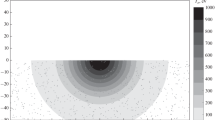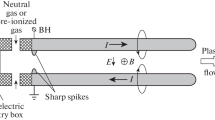Abstract
In pulsed plasma accelerators of various configurations it is frequently possible to observe an instability of the current sheet characterized by separation into individual narrow channels (local “pinches”). In this paper the flow of plasma over these channels is qualitatively investigated. It is shown that a large part of the discharge current can flow through a series of narrow channels only when they completely decelerate the plasma flow. This places upper and lower bounds with respect to pressure on the region of existence of the pinch structure, if it is assumed that deceleration by the magnetic field predominates over viscous deceleration. The upper bound is obtained from the condition of deceleration of the plasma by the magnetic field near the pinches, the lower bound from the condition that the ratio of specific heats of the gas γ must be small. As the initial gas pressure decreases, so does the plasma deceleration time, but the characteristic times of the excitation and ionization processes increase; therefore the condition γ≈1 ceases to be satisfied. The results are compared with experiment. The induced currents in the plasma near the pinches are also a reason for the stability of the network of current filaments.
According to [1] a pulsed high-current discharge in a low-pressure gas develops as follows. After breakdown and the attainment of a certain uniform value of the gas conductivity the current continues to increase only in a surface layer (skin effect), which, if the particle density is sufficient, acts as an impermeable piston on the gas in front of it (“snowplow” model). Clearly, to judge from the collapse time of the current cylinder [2], this gives a good picture of the situation in the Z pinch. However, in coaxial and rail guns the gas is by no means always completely raked up by the current sheet (see, for example, [3]). This is also indicated by the observed broad spectrum of plasmoid velocities.
It has been noted in high-speed photographs of pulsed discharges of very different configurations (Z and θ pinches, coaxial and rail plasma guns) that the current sheet is often divided into a series of channels [4–12], through which the main current flows. This follows from their high acceleration as compared with the rest of the plasma [4, 5], from the arrangement of the cathode spots along the electrodes, and from the large value of the plasma density in the channels [11]. This effect is well reproduced from discharge to discharge.
Experiments with the Z pinch [7] have shown that the division of the current sheet into pinches has almost no effect on its velocity, which is in good agreement with calculations based on the “snowplow” model, although the diameter of the channels (determined, it is true, from the luminescence distribution and not the current density) is much less than the distance between them. On the other hand, in rail guns the pinches only slightly entrain the gas filling the tube [11]. The surface layer pinch instability is observed in the pressure range from several mm to several μ Hg [9]. Both pressure limits depend heavily on the nature of the gas in which the discharge takes place, the upper limit being approximately inversely proportional to the molecular weight of the gas [9], In a rail gun at low initial gas pressures (p < <20 μ Hg) pinches appear at some optimal rate of gas release from the electrodes and the walls [12].
A uniform transverse magnetic field has only a slight influence on the pinches, since it is smaller in magnitude than the magnetic field of the pinches themselves [11]. A transverse magnetic field nonuniform along the length of the pinches causes them to decay, if the magnitude of the external field is comparable with the pinch field. Pinch decay was observed by the author in a rail gun when one of the electrodes was cut out so that on a certain section of the rail its transverse dimension was reduced to the diameter of the pinch, which was much less than the distance between electrodes (this setup was described in [11]).
The instability of a plane current sheet in a plasma has been demonstrated on several occasions [13, 14]. Under experimental conditions the “pinches” move through the plasma. Therefore we will consider the case when a considerable part of the discharge current flows through a series of narrow channels (assuming that for this case the conductivity of the pinches is infinite).
Similar content being viewed by others
References
S. I. Braginskii and A. B. Migdal, “Processes in a plasma column with rapid current buildup,” in: Plasma Physics and the Problem of Controlled Thermonuclear Reactions [in Russian], vol. 2, izd-vo AN SSSR, 1958.
L. A. Artsimovich, Controlled Thermonuclear Reactions [in Russian], Fizrnatgiz, 1961.
L. C. Burkhardt and A. H. Lovberg, “Current sheet in a coaxial plasma gun,” Phys. Fluids, vol. 5, no. 3, 1962.
V. S. Komel'kov, “Pinched discharges in deuterium at large current buildup rates,” ZhETF, vol. 35, no. 1, 1958.
I. F. Kvartskhava, K. N. Kervalidze, G. G. Zukakishvili, and Yu. S. Gvaladze, “Use of an auxiliary discharge to investigate the properties of plasma in the theta pinch with a trapped reverse magnetic field,” Yadernyi sintez, vol. 3, no. 3, 1963.
F. L. Curzon and R. J. Churchill, “Framing camera studies of Z pinch in nitrogen,” Canad. Journ. Phys., vol. 40, no. 9, 1962.
F. L. Curzon, R. J. Churchill, and R. Howard, “Pressure dependent characteristics of the Z pinch in argon and nitrogen,” Proc. Phys. Soc., vol. 81, no. 2, 1963.
F. L. Curzon, R. J. Churchill, and R. Howard, “Streamers in the nitrogen pinch,” Phys. Letters, vol. 1, no. 8, 1962.
R.J. Churchill and F. L. Curzon, “Axial streamers in the Z pinch,” “Compt. Rend. 6 Conf. Internat. Phénoménes Ionizat. Gaz,” Paris, vol. 2, 1963.
I. F. Kvartskhava, R. D. Meladze and K. V. Suladze, “Experiments on electrodynamic plasma acceleration,” ZhTF, vol. 30, no. 3, 1960.
V. N. Grigor'ev, “Plasmoid structure in an electrodynamic accelerator,” PMTF [Journal of Applied Mechanics and Technical Physics], no. 2, 1965.
V. N. Grigor'ev, “Pinches observed in plasma rail guns,” PMTF [Journal of Applied Mechanics and Technical Physics], no. 4, 1965.
Tanaka Masatoshi, “An instability of the accelerated plasma,” J. Phys. Soc. Japan, vol. 20, no. 1, 1965.
H. P. Furth, J. Killen, and M. N. Rosenbluth, “Finite-resistivity instabilities of a sheet pinch,” Phys. Fluids, vol. 6, no. 4, 1963.
V. L. Granovskii, Electric Current in a Gas [in Russian], vol. 1, Gostekhizdat, 1962.
B. N. Klyarfel'd and L. G. Guseva, “Nature of the positive current-voltage characteristics of a lowpressure electric discharge,” ZhTF, vol. 35, no. 2, 1965.
V. D. Andreev, Investigation of the Mechanism of Formation of the Cathode Spot of a Nonthermal Low-Pressure Arc, Dissertation, All-Union Order of Lenin Electrical Engineering Institute, 1949.
E. I. Tamm, Fundamentals of the Theory of Electricity [in Russian], Gostekhizdat, 1954.
Author information
Authors and Affiliations
Additional information
In conclusion, the author thanks A. K. Musin for his helpful suggestions.
Rights and permissions
About this article
Cite this article
Grigor'ev, V.N. Some conditions for the existence of a “Pinch” structure of the current sheet in plasma. J Appl Mech Tech Phys 7, 36–39 (1966). https://doi.org/10.1007/BF00912623
Issue Date:
DOI: https://doi.org/10.1007/BF00912623




